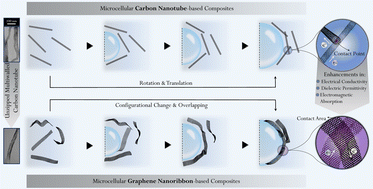Enhanced electrical properties of microcellular polymer nanocomposites via nanocarbon geometrical alteration: a comparison of graphene nanoribbons and their parent multiwalled carbon nanotubes†
Abstract
Geometric factors of nanofillers considerably govern the properties of conductive polymer composites (CPCs). This study provides insights into how geometrical alteration through nanotube-to-nanoribbon conversion affects the electrical properties of solid and microcellular CPCs. In this regard, polyvinylidene fluoride (PVDF)-based nanocomposites are synthesized using both the parent multi-walled carbon nanotube (MWCNT) and its chemically unzipped product, i.e., graphene nanoribbons (GNRs). Theoretical and experimental results show that GNR-based composites exhibit 1–4 orders greater conductivities than MWCNT-based composites at the same filler loading because of the larger number of filler–filler junctions as well as the significantly greater contact areas. On the other hand, the conductivities of MWCNT-based and GNR-based composites are significantly increased by 230 times and 121 times, respectively, through microcellular foaming. The effective rearrangements of rigid MWCNTs and flexible GNRs (having 4 and 5 orders less bending stiffness) for network formation during cellular growth are compared. The GNR-based composites also exhibit a superior dielectric permittivity (e.g., 2.6 times larger real permittivity at a representative frequency of 103 Hz and a nanofiller loading of 4.2 vol%) compared to their MWCNT-based counterparts. This study demonstrates how the modification of the carbon fillers and the polymer matrix can dramatically enhance EMI shielding.



 Please wait while we load your content...
Please wait while we load your content...